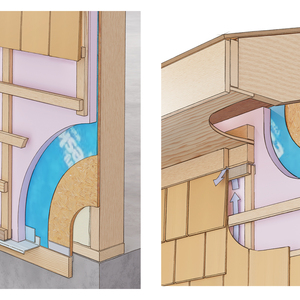Most efficient plaster & lathe removal?
Hello all. Please give me your experienced input on the fastest, most efficient technique to remove the plaster & lathe from a 10′ high x 20′ long wall in 110 yr. old house. I’ve never ripped it out before and any experienced insight (which tools, what bonding agent at the inside corners, what to look out for, etc…) would be appreciated. The wall will be replaced with 1/2″ drywall and each end and the ceiling inside corners will be joined with the existing plaster & lathe surfaces. Thanks.



















Replies
To remove plaster and lathe........use a hammer and beer! lol
One important thing is to use a good dust mask and goggles because you have no idea the dust that will be in the air.
Also another great tool is....contractor garbage bags to shovel the debris into and haul out of your house. They hold almost 80 lbs.
This project isn't rocket science, just labor intensive.
Have fun, cough cough.
Be well
andy
In his first interview since the stroke, Ram Dass, 66, spoke with great difficulty about how his brush with death has changed his ideas about aging, and how the recent loss of two old friends, Timothy Leary and Allen Ginsberg, has convinced him that now, more than ever, is the time to ``Be Here Now.''
http://CLIFFORDRENOVATIONS.COM
OK here goes,
110 years old? Probably no expanded metal at corners and probably wood lath. To get a clean cut in the corners you might use a Sawzall. In the field, circular saws and even small grinders work well. However, in a corner the Sawzall is probably best. Oftimes the best blade is a plaster blade ( designed to cut plaster). However, with the wood lath, a course aggresive wood blade may be better ( you will just use more of them!)
As for finishing, the 1/2" drywall and normal finishing technigues will work (tape, block and skim).
I'm sure others may say different...
Good luck! Messy, dusty work but the results can be "just fine".
My best luck for a relatively gentle removal (if that's possible) is to use a pry bar to release the lathe at the studs as you work your way down. This allows you to kind of control the fall of the debris. When I was pulling at it with a hammer it was flinging stuff over a much larger area.
I also like putting a large canvas tarp down under where I'm working and then periodically bundle it up and carry it outside for collection later (in my case a patio) or to a dumpster or wherever.
If you're living in this house, tape plastic up over all entrances to this room and point a fan outside if possible. It will absolutely fill your house with dust.
Be careful of K&T wiring if you still have any.
Also, I just noticed someone above mention using a grinder to cut it. I had an electrician do that in my ceilings to do some work and it worked great for him. However, I scared the heck out of myself when I tried it because the lathe started smoking while I was cutting. I stopped and held my breathe and watched a second and thought sure I saw more smoke. I started ripping it off like mad and made a huge mess. I thought sure I'd started a fire in the wall. It was a majore adrenaline rush. Just be careful.
Edited 8/20/2003 9:50:13 AM ET by CAMPBELLDUST
True!
A 4" ginder w/ thin blade does well in the field on PLASTER, not wood. Since this dude is working in the inside corners a Sawzall seems to be the drug of choice. And also remember, A "110 year old house" does not always mean a 110 year old plster. Some modest investigation will reveal whether wood lath, metal corners, etc.
If you're lucky enough to have a layer or two of wallpaper on that plaster wall, you can remove the bulk of the material by cutting upwards between the studs from floor to ceiling creating strips that stay together when they fall. Try cutting up about 5' and then remove that much. Continue with the remainder as a separate strip.
Again.......you have to aware and careful about avoiding damage to any wiring or plumbing inside the wall that you want to keep.
Sawzall has a great lath and plaster blade. That said, after hundreds of walls destructed I must say, Just whack it! Dust, to say the least. If you have a strong fan put it in the window blowing out. Wear mask, very important, and eye wear. Plastic cover all openings, this dust will travel all the way into the next state.
Loud music and absolutely, beer. But after work, water during.
Bang the opposite side from behind.
Good luck
J.ust A G.uy W.ith A H.ammer
Got to agree with ya. Just took plaster and lathe out of my house. Had this great idea that I would drill to find studs and use a sawzall. Take it out in big chunks, no muss no fuss no dust.
Yeah right.
Prybar was much quicker and actually less dust. Sawing creates lots of fine dust. Pulling it down created less. I put a filter over my fan to minimize the amount of dust that went outside.
I like to do it fairly slowly. I set a big garbage can in front of me, and work over the top of it. I pop chunks of the stuff loose with a flat bar and drop them straight in the garbage can. I catch about 80% of it that way - Saves on the sweeping and shoveling.
Then I take the can out to a dumpster on a dolly when it's about half full, so it ain't too heavy to empty.
Having a fan or 2 sucking air outside is a big help. I've had as many as 3 going, trying to keep the dust controlled. Still, a good supply of dust masks is a must. And safety glasses or goggles. And gloves.
Is It Cold In Here, or Is It Just You?
If you can find the stud (?) nearest the corner, try to run a saw down beside it to cut the lath. If you don't, chances are you'll destroy the adjoining walls due to the lath vibrating and breaking.
House I grew up in was ~200 yr old, and the "studs" were 30-36" apart. If you broke a lath in between, the plaster was often destroyed 4 to 5 ft away. And I'd be afraid that the sawzall would give you headaches on the adjoining walls, which, if I'm reading correctly, you are hoping to save. For the brute force method, a stanley wonderbar or the like and a good hammer do wonders: at each stud, drive the end of the wonderbar under the lath, and pry.
The dust will be heck on earth. If the room has a window, get a honking big fan blowing out the window; also, seriously tape off every possible opening between this room and anywhere else you don't want to clean. Until you've done it, you really can't imagine. And a seriously good dust mask is obligatory. You may still be eating grit, and blowing nose fuls of black soot for days.
THE tool that works best for us is a crowbar/prybar thing called a Wreaker. It allows you to hook behind the lath and pull, and pry under pieces that are particularly stubborn.
Allows you to be the young bull, or the old bull.... y'know "Two bulls are at the top of the hill looking down on a field of heifers. The young bull says 'Lets run down there and make it with one of them'. The old bull says 'Nah, lets walk down there and make it with all of them.' ". I like to work along a joist with the pry end, where my 22yr old young bull of a brother likes to come-a-swingin' with the claw part.
And, sawzall all edges that you want to be clean.
By reading all 10 of my feedbacks to my question, I feel like I understand exactly how to proceed. Thanks for the input and I'm definitely getting the "Wreaker" bar and sealing that room off to contain the dust. All responses are graetly appreciated.
Wait!
Waitup!
Don't start without me. I love to tear off plaster!
Well sometimes I lie.
;)
But you still don't have a total understanding yet.
I'm a little bit of a neat freak but istill get along with this kind of work. Andy had a hint with the beer, but beer isn't strong enough for this kind of dust. You'll need grapefruit juice and Vodka. The acid helps neutralize the alkalii dust in your throat - you will have some no matter how good a dust mask you use. And using vinegar to rinse in the shower will make the soap more effective too. Just be carefull about spalshing it in your eyes or other sensitive places.
One thing that I hate about this is separating lathe and plaster when it's all jumbled on the floor. The lathe is up to four feet long and is tangled with itself. Add some wallpaper and the scoop shovel gets laughed off.
So I use a flat spade to tear off the plaster first. (see it in the attachemnt behind the bathtub - you can buy the same kind with a long handle which might help with your tall wall, but I like to be above the work as much as possible) Once you get a start, it will slide right along and big sheets of plaster fall while leaving the lathe up. Like Boss, I try to let it fall into a recepticle, even a carboard box. (heavy duty and empty it often or it will still be sitting there tom,orrow, anchored to the floor by gravity)
After the plaster is off and mostly removed, I go after the lathe, usually with a flat bar but sometimes with the wizard which is the name I know for the wrecking bar mentioned above. I get a pretty good rythym popping them loose with one hand and spinning them into the garbage can with the other. That way I don't have to pick them up again or walk all over them. Of course, if there are no windows or doors and you are going for the open studs to wire or insulate, you can leave the lathe on the studs and sheet rock over them with 3/8" rock and glue.
protecting the floor is a given, but you may not realize how much you have to give it. We tape down a visqueen, then a layer of cardboard or homasote, then a drop cloth or tarp for gathering the majority of the leavings.
Seal the room as much as possible and set a window fan to exit the air flow - but not into the neighbor's window or parked car. I use an air scrubber in the room wqhere the work is happening.
As for cutting the corner, I use the flat bar and a hammer, working it like a cold chisle right into the corner, before starting the tearoff of the field. You want that cut done first or you will have chunks off the other walls too.
Good luck and don't forget the grapefruit juice. Wait until end of day for the vodka. I would plan this job to do all the prep work and set up the day before and then do ALL the plaster work in one day, even if a long one. This is because after doing it, you will never want to do it again. If you are still looking at a half finished job the next morning, you may be adding the vodka to your morning orange juice, LOL
.
Excellence is its own reward!
Thats good stuff. FYI, I'm trim/finish carpenter hired for this job. I just told him we'd rip the wall out for him and we don't typically do the demolition. The wall has to be removed because it has substantial water damage (which is, of course, been repaired). Thanks a million, all this insight gives me all the confidence I need to knock this job out!
There's only a bit to add to the fine tips. Turn off the air so you don't suck that dust into the rest of the house. Seal the air return and ducts in the room b/4 you start so the latent dust isn't introduced into the system. And remember the lath nails are like needles. Wear good gloves.Remodeling Contractor just outside the Glass City.
Quittin' Time
This forum is great! I thought I was the only self-employed carpenter (aren't we self-employed so we can take only the fun jobs?) who got into such work. All the tips are good. I like to suggest leaving the lath on if it suits your purposes. For those who have an interest in old house history, the lath is part of the history. I've used a spud to separate plaster from lath. It has a retangular blade about 6x4 inches straight in line with a long handle. But the square garden spade works well too. Among the disadvantages to leaving on the lath is that lots of little chunks of plaster are left hanging between the lath with have a tendency to work themselves proud at the worst time (like when you've got a sheet of dw halfway fastened on with a lump poking out somewhere midway). Any by all means, cleanup is facilitated by removing the plaster and lath in separate stages.
my turn, my turn!
first find out how the corners are joined at the ceiling and adjacent walls- your project is probably too old to have expanded metal, but check carefully anyway. one way or another (depending on what you find underneath) go around the entire wall with a brick chisel/grinder/small air impact chisel- whatever- to separate it from the adjacent surfaces. if you don't do this first there is a very high likelihood that you'll be doing some serious patching.
second, if this house has any sort of forced air hvac, sometimes they used the joist and stud bays for the returns (no actual ductwork). make sure any of those are blocked if you happen to open them up in demo. you'll know what i mean if the heat or ac kicks on while you're working (learned this one the hard way!)
third- this crap is WAY heavy! don't figure on choking a big trash barrel with it then hauling down/up a couple flights of stairs. if at all possible, dump it out the window with a chute into a minidumpster or something- don't carry it any farther than you have to.
have fun!
m
Dust mask & gogles, or ....._______________________
Worship is not an hour in a building; even in a building dedicated to God.
Worship is an encounter with the holy presence of God!
After cutting the plaster loose from the lathe, I run (drag) a large screwdriver tip of the corner of my flat nail bar along the grooves to push those clinkers back into the wall cavity. then run my shop vac over the wall to pull dust off it and a few loose dangling clinkers. Rarely get that problem. The Rock hangers always say things like "Wow, this is great!".
Excellence is its own reward!
Sorry for no repsonses. We just got back from a short trip to Raleigh, North Carolina. The house still has the old hot water radiators and no A/C so the biggest focus for my guys is sucking the dust out the windows with the assistance of as many fans as possible. We already made the arrangements with the carting company to drop the dumpster right outside the window and a temporary chute made of plywood will be assembled to throw the stuff right out. At this point, I think our biggest reaining concern is separating the nside corners at the wall and ceiling corners so that we don't crumble the remaining surfaces.
I don't know if this will work but I wonder if you wet the walls if it will cut down on the dust and I would measure how thick it was and cut it between the studs top to bottom with concrete saw blade in my circle saw.
ANDYSZ2I MAY DISAGREE WITH WHAT YOUR SAYING BUT I WILL DEFEND TO THE DEATH YOUR RIGHT TO SAY IT.
daddio, This is what I've done at different times to score/cut the corners. In cases where metal corner mesh was used, a sawzall w/ short plaster cutting blade. Hold the sawzall at a 45 deg. angle to the wall/ceiling, enter the plaster and cut right thru both the plaster and the metal lath. Watch your depth for wires, plumbing etc.
If no metal corner lath, I've used the sawzall/plaster blade, chisel and hammer, and even the hatchet end of a drywall hammer. You are trying to score the corner, no need to cut all the way through.
Remodeling Contractor just outside the Glass City.
Quittin' Time
Edited 8/23/2003 10:28:15 AM ET by calvin
The tip about the fan is also reallyyyyyy important but be sure you don't put the fan "in" the window as I've seen so many people do. It'll just clog up the motor...keep it at the far end of the room "facing the window".
Piffs advice about using the end of your flat bar to push in those wire nasties is right.
In my old house I don't have any inside wire nasties and I hope the same for you.
Wood lathe is a breeze (so to speak). I never found the need for a saw if its just wood. The stuff pretty much just pulls right off.
Its the dust man, its the dust!
Be well
andy
In his first interview since the stroke, Ram Dass, 66, spoke with great difficulty about how his brush with death has changed his ideas about aging, and how the recent loss of two old friends, Timothy Leary and Allen Ginsberg, has convinced him that now, more than ever, is the time to ``Be Here Now.''
http://CLIFFORDRENOVATIONS.COM
Taylorsdad,
Was reading through this post to see if anybody would mention the importance of doing it in stages and of couse....it was Piffin.
I tore every speck of plaster and lath out of my 2400sq. ft. circa 1920's house and have to agree. Seal the room from the rest of the house. knock down all the plaster first with a sledge hammer. wrecking bar, whatever. Clean up the mess on the floor and put it in "contractor clean-up" bags (per Andy C.) Then go after the wood lath. The broken lath and protruding nails tend to tear the plastic bags, so I always burn it... BTW, old lath makes great kindling. But heavy paper, like old fertilizer bags, seem to work too if burnin isn't an option.
Jon
Why are you removing the plaster? Is it necessary? Just asking because my house is 95 years old and I opted for a skim coat, worked out pretty nice.
Don't think I've seen it mentioned yet, but, a hat or bandana tied over your head is also nice to keep from picking grit from your scalp for the next couple days
prep, suit up, turn on the fan, and giv'er